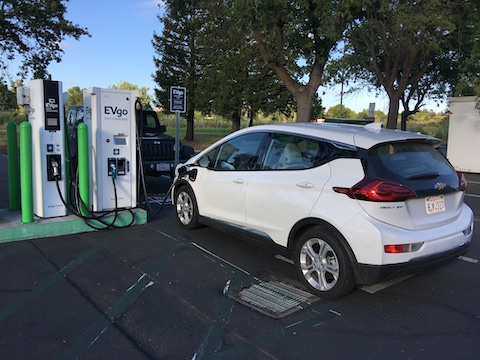
Pretty much everybody who is curious about electric vehicles and learns that I have a Chevy Bolt begins with the same few questions: How do you like it? How far can it go? How long does it take to charge?
The first two can be answered easily enough (very much, and 238 miles in normal circumstances). But the last question inevitably requires a longer explanation. Because the answer is – it really does depend. A lot. Yes it can charge in 2 hours 15 minutes. But it can also charge in 9 hours. Or 20. It all depends.
The main problem is that the frame of reference – that of a gasoline vehicle – is not helpful here. Most gasoline vehicles can be refilled in 5 minutes or so. The time is short enough that most people don’t notice the difference between a 10 gallon tank and 20 gallon one. It is actually true that some pumps are slower than others, but unless you’re unlucky enough to have a really uncooperative one, the differences are rarely measurable.
Modern EVs all rely on a larger capacity lithium ion battery for propulsion (often this is called the ‘traction battery’). The Bolt’s battery has a capacity of 60kWh (2017-2019). However the battery pack is composed of many smaller cells that are quite similar to those in smartphones. Like the batteries in your smartphone, the chemistry of these batteries means that they tend to degrade if charged to too high a level, discharged to too low a level, if charged too quickly, or if they heat up too much. The net result is that EVs (like smartphones) has a sophisticated software system to regulate charge and discharge such that battery life is maximized.
What this means for EV charging is that the vehicle varies that rate at which the battery charges. In particular, the charge rate tends to decrease (taper) as the battery gets more full. Also, if the battery temperature is very low or very warm, the charge rate is usually reduced. Further complicating matters is that most EVs offer two types of charging: AC and DC.
AC charging takes power directly from the grid, through an EVSE (EV supplementary equipment – essentially a ‘smart’ extension cord) to the charger built into the car, which converts it to DC and feeds it into the battery. AC charging speed is effectively limited first by the on-board charger, then by the EVSE, and lastly by the circuit the EVSE is connected to. The car essentially negotiates with the EVSE for a rate that both can support. Notably for this to work, the EVSE must be connected to a circuit capable of matching it’s maximum output – if not, you can trip the breaker or potentially start a fire.
In the case of the Bolt, the on-board charger allows up to 7.2kW provided the input is 240V (annoyingly, it limits you to 1.4kW if the input is 120V). To supply this much power, your EVSE must therefore support at least 32A at 240V. This in turn means the circuit the EVSE is connected to should be capable of supplying 40A, since electrical code requires no device draw more than 80% of the rated current capacity continuously.
So a 60kWh battery supplied at 7.2kW would get you 8h20 charge time, right? Not quite. Remember, the battery charge speed tapers as it fills up. In practice 9 hours is the best case for AC charging. But suppose you don’t have a 40A 240V circuit to hook up to? Well, it’ll take longer. The most common scenario is using a regular 120V wall outlet. Here the car limits you to 12A (1.4kW), so you’re looking at a nearly 40 hour charge time. In fact the car defaults to only 8A on 120V, probably due to fears of inadequate wiring in older houses, making for a charge time of 60 hours! The saving grace is that one rarely charges from completely empty.
DC charging complicates matters further. The charger is completely separate from the car, but the car still sets the maximum rate at which it will accept charge. DC chargers are typically much faster than AC chargers – most can supply 50 or 60kW of power but some go as high as 175kW (for 380V vehicles). To deal with this amount of power, all vehicles taper the charge rate above a certain point. Additionally, they also reduce the charge rate if the battery temperature is either too low or too high.
The Bolt has a particularly aggressive tapering strategy. First, the vehicle is limited to 55kW charging in all circumstances. Second, max charging speed is determined by battery charge:
-
0-55%: 55kW
-
55-68%: 38kW
-
68-86%: 24kW
-
86-94%: 16kW
-
94-100%: 10kW gradually decreasing
But that’s not the end of the story. As mentioned earlier, battery temperature also limits the maximum charging rate. Chevy seems to use a linear function, but the following points are notable:
-
77-104 degrees: 55kW – outside this temperature range, you will see lower charge rates
-
68 degrees: 37kW
-
50 degrees: 19kW
-
32 degrees: 11kW
Unfortunately, you don’t get direct control over the battery temperature. There is a battery heater, but the only way to activate it is preconditioning the car (turning it one while plugged in to AC power) or starting a DC charge. Even driving at 65mph in the winter may not do much to warm the battery.
So what have we learned then? In optimal conditions, you can charge from 0-100% in about 2h15 at a DCFC. Or you could charge from 0-55% in 35 minutes. Or 0-80% in about an hour. Or under non-optimal conditions, it will definitely take longer.
